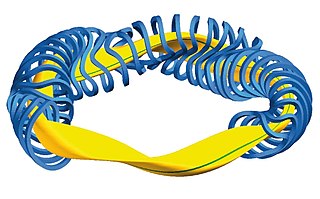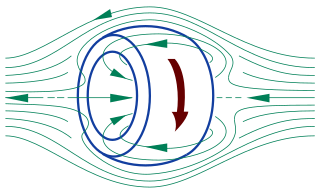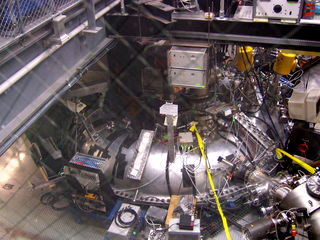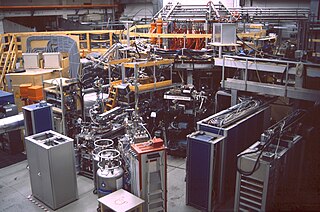The Glasser effect describes the creation of singularities in the flow field of a magnetically confined plasma when small resonant perturbations modify the gradient of the pressure field.

A stellarator is a plasma device that relies primarily on external magnets to confine a plasma. Scientists researching magnetic confinement fusion aim to use stellarator devices as a vessel for nuclear fusion reactions. The name refers to the possibility of harnessing the power source of the stars, such as the Sun. It is one of the earliest fusion power devices, along with the z-pinch and magnetic mirror.
Thermonuclear fusion is the process of atoms combining or “fusing” together with huge amounts of heat. There are two forms of thermonuclear fusion: uncontrolled, in which the resulting energy is released in an uncontrolled manner, as it is in thermonuclear weapons and in most stars; and controlled, where the fusion reactions take place in an environment allowing some or all of the energy released to be harnessed for constructive purposes.

A reversed-field pinch (RFP) is a device used to produce and contain near-thermonuclear plasmas. It is a toroidal pinch which uses a unique magnetic field configuration as a scheme to magnetically confine a plasma, primarily to study magnetic confinement fusion. Its magnetic geometry is somewhat different from that of the more common tokamak. As one moves out radially, the portion of the magnetic field pointing toroidally reverses its direction, giving rise to the term reversed field. This configuration can be sustained with comparatively lower fields than that of a tokamak of similar power density. One of the disadvantages of this configuration is that it tends to be more susceptible to non-linear effects and turbulence. This makes it a useful system for studying non-ideal (resistive) magnetohydrodynamics. RFPs are also used in studying astrophysical plasmas, which share many common features.

A levitated dipole is a type of nuclear fusion reactor design using a superconducting torus which is magnetically levitated inside the reactor chamber. The name refers to the magnetic dipole that forms within the reaction chamber, similar to Earth's or Jupiter's magnetospheres. It is believed that such an apparatus could contain plasma more efficiently than other fusion reactor designs. The concept of the levitated dipole as a fusion reactor was first theorized by Akira Hasegawa in 1987.

Magnetic confinement fusion is an approach to generate thermonuclear fusion power that uses magnetic fields to confine fusion fuel in the form of a plasma. Magnetic confinement is one of two major branches of fusion energy research, along with inertial confinement fusion. The magnetic approach began in the 1940s and absorbed the majority of subsequent development.

A field-reversed configuration (FRC) is a type of plasma device studied as a means of producing nuclear fusion. It confines a plasma on closed magnetic field lines without a central penetration. In an FRC, the plasma has the form of a self-stable torus, similar to a smoke ring.

Mega Ampere Spherical Tokamak (MAST) was a nuclear fusion experiment, testing a spherical tokamak nuclear fusion reactor, and commissioned by EURATOM/UKAEA. The original MAST experiment took place at the Culham Centre for Fusion Energy, Oxfordshire, England from December 1999 to September 2013. A successor experiment called MAST Upgrade began operation in 2020.

The Madison Symmetric Torus (MST) is a reversed field pinch (RFP) physics experiment with applications to both fusion energy research and astrophysical plasmas.
The H-1NF is a research institute of the H-1 heliac, a large stellarator device located in the ANU Research School of Physics and Engineering at Canberra, Australia. It was established when the H-1 heliac was promoted to a national facility in 1996, adopting H-1NF as its facility name.

Alcator C-Mod was a tokamak that operated between 1991 and 2016 at the Massachusetts Institute of Technology (MIT) Plasma Science and Fusion Center (PSFC). Notable for its high toroidal magnetic field, Alcator C-Mod holds the world record for volume averaged plasma pressure in a magnetically confined fusion device. Until its shutdown in 2016, it was one of the major fusion research facilities in the United States.

The National Spherical Torus Experiment (NSTX) is a magnetic fusion device based on the spherical tokamak concept. It was constructed by the Princeton Plasma Physics Laboratory (PPPL) in collaboration with the Oak Ridge National Laboratory, Columbia University, and the University of Washington at Seattle. It entered service in 1999. In 2012 it was shut down as part of an upgrade program and became NSTX-U, for Upgrade.

A flux tube is a generally tube-like (cylindrical) region of space containing a magnetic field, B, such that the cylindrical sides of the tube are everywhere parallel to the magnetic field lines. It is a graphical visual aid for visualizing a magnetic field. Since no magnetic flux passes through the sides of the tube, the flux through any cross section of the tube is equal, and the flux entering the tube at one end is equal to the flux leaving the tube at the other. Both the cross-sectional area of the tube and the magnetic field strength may vary along the length of the tube, but the magnetic flux inside is always constant.

The interplanetary magnetic field (IMF), now more commonly referred to as the heliospheric magnetic field (HMF), is the component of the solar magnetic field that is dragged out from the solar corona by the solar wind flow to fill the Solar System.

The Helically Symmetric Experiment, is an experimental plasma confinement device at the University of Wisconsin–Madison, with design principles that are intended to be incorporated into a fusion reactor. The HSX is a modular coil stellarator which is a toroid-shaped pressure vessel with external electromagnets which generate a magnetic field for the purpose of containing a plasma. It began operation in 1999.
The Columbia Non-neutral Torus (CNT) is a small stellarator at the Columbia University Plasma Physics Laboratory designed by Thomas Sunn Pedersen with the aid of Wayne Reiersen and Fred Dahlgren of the Princeton Plasma Physics Laboratory to conduct the first investigation of non-neutral plasmas confined on magnetic surfaces. The experiment, which began operation in November 2004, is funded by the National Science Foundation and the United States Department of Energy in the form of a Faculty Early Career Development (CAREER) award.
Magnetized Target Fusion (MTF) is a fusion power concept that combines features of magnetic confinement fusion (MCF) and inertial confinement fusion (ICF). Like the magnetic approach, the fusion fuel is confined at lower density by magnetic fields while it is heated into a plasma. As with the inertial approach, fusion is initiated by rapidly squeezing the target to greatly increase fuel density and temperature. Although the resulting density is far lower than in ICF, it is thought that the combination of longer confinement times and better heat retention will let MTF operate, yet be easier to build. The term magneto-inertial fusion (MIF) is similar, but encompasses a wider variety of arrangements. The two terms are often applied interchangeably to experiments.

The Princeton field-reversed configuration (PFRC) is a series of experiments in plasma physics, an experimental program to evaluate a configuration for a fusion power reactor, at the Princeton Plasma Physics Laboratory (PPPL). The experiment probes the dynamics of long-pulse, collisionless, low s-parameter field-reversed configurations (FRCs) formed with odd-parity rotating magnetic fields. It aims to experimentally verify the physics predictions that such configurations are globally stable and have transport levels comparable with classical magnetic diffusion. It also aims to apply this technology to the Direct Fusion Drive concept for spacecraft propulsion.
A magnetic nozzle is a convergent-divergent magnetic field that guides, expands and accelerates a plasma jet into vacuum for the purpose of space propulsion. The magnetic field in a magnetic nozzle plays a similar role to the convergent-divergent solid walls in a de Laval nozzle, wherein a hot neutral gas is expanded first subsonically and then supersonically to increase thrust. Like a de Laval nozzle, a magnetic nozzle converts the internal energy of the plasma into directed kinetic energy, but the operation is based on the interaction of the applied magnetic field with the electric charges in the plasma, rather than on pressure forces acting on solid walls. The main advantage of a magnetic nozzle over a solid one is that it can operate contactlessly, i.e. avoiding the material contact with the hot plasma, which would lead to system inefficiencies and reduced lifetime of the nozzle. Additional advantages include the capability of modifying the strength and geometry of the applied magnetic field in-flight, allowing the nozzle to adapt to different propulsive requirements and space missions. Magnetic nozzles are the fundamental acceleration stage of several next-generation plasma thrusters currently under development, such as the helicon plasma thruster, the electron-cyclotron resonance plasma thruster, the VASIMR, and the applied-field magnetoplasmadynamic thruster. Magnetic nozzles also find another field of application in advanced plasma manufacturing processes, and their physics are related to those of several magnetic confinement plasma fusion devices.

The Compact Toroidal Hybrid (CTH) is an experimental device at Auburn University that uses magnetic fields to confine high-temperature plasmas. CTH is a torsatron type of stellarator with an external, continuously wound helical coil that generates the bulk of the magnetic field for containing a plasma.

Wendelstein 7-AS was an experimental stellarator which was in operation from 1988 to 2002 by the Max Planck Institute for Plasma Physics (IPP) in Garching. It was the first of a new class of advanced stellarators with modular coils, designed with the goal of developing a nuclear fusion reactor to generate electricity.